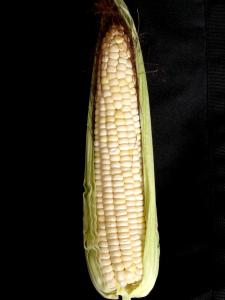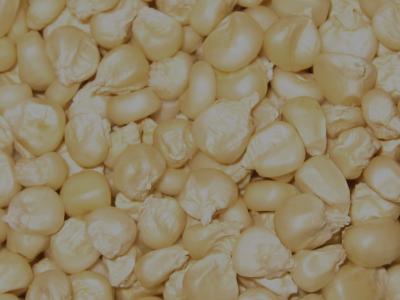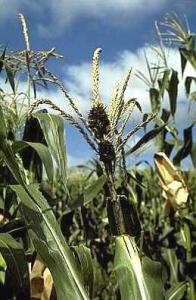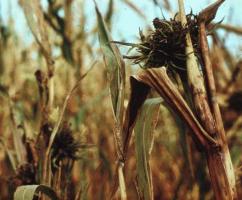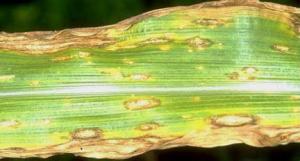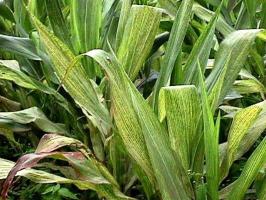
|
Maize Seed Production
Pests and Diseases:
|
| Introduction | Seed plot system | |||
| Production of own maize seed by smallholder farmers | Information Source Links | |||
| Guide to knowing disease affected plants |
Introduction
|
Maize has for many years been the crop against which food security is measured in Kenya. However, when it comes to seed supply, farmers are often at the mercy of large seed companies and may not always be able to get the kind of seed they want. In many maize producing areas farmers have kept and multiplied old maize varieties, which over time have become better adapted to their climatic zones, better able to withstand extreme weather conditions and at least provide them with a yield when hybrids fail.
Also Kenya Agricultural Research Institute (KARI) has maintained some of the old open pollinated varieties for their research and developed new ones especially for dryland areas, where the seed companies do not have much to offer.
The following is a listing of best practices for maintaining and developing the best type of maize seed for particular areas. Farmers interested in maintaining their own seed supply can possibly find inspiration here.
|
Production of own maize seed by smallholder farmers
Own maize seed can only be produced from varieties which are not hybrids. Hybrid varieties are made by planting two varieties in the same field, allowing only the male parent to produce pollen, and harvesting the seed only from the female parent. This is controlled crossing of two different parents. The offspring (the hybrid) will perform better than the average of the parents or even better than each of the parents. Generally hybrid maize varieties are denoted by letter "H". Some examples of hybrid maize varieties in Kenya include: "H 614", "H 626", "KH 600-15A", "H 516", "KH 500-21A", "Pwani Hybrid 1" and "Pwani Hybrid 4".However if you try to plant the seeds from the cobs of these hybrids, your plants will not have the characteristics of the mother plants and also the yields would be different.
Non-hybrid (open pollinated) varieties are produced by allowing maize plants to pollinate freely, and seed can be harvested from all healthy plants. Some examples of open pollinated maize varieties in Kenya: "Coast Composite", "Katumani Composite B", "DLC1", "Kikuyu" (a landrace which is popular in the Central Province of Kenya). A landrace is a variety developed by farmers under influence of their farming system and their physical environment (soils and weather). Landraces are characterised by high genetic variation
|
|
How to produce on-farm own seed from non-hybrid (open pollinated) maize varieties
Sources of seed
If you want to start your own seed multiplication programme as an income generating activity, buy seed which is certified for example in Kenya, by the Kenya Plant Health Inspectorate Service (KEPHIS). In other countries in the region, check on certifying institutions. In Kenya, ensure that you consult KEPHIS, extension officers of Ministry of Agriculture or the nearest Kenya Agricultural Research Institute (KARI) centre on the required procedures and regulations for seed production and sale in Kenya.
If you want to produce seed for your own use (and sharing with neighbours), you can source seed from your existing maize crop in your farm provided it is not a hybrid maize crop. Or if in Kenya, you can visit your nearest KARI field station and see if they can supply an initial small amount of seeds of a suitable open pollinated variety for your area. Plant this local seed variety and select the best cobs in your field according to the following principles:
Basic procedure in producing own seeds:
1.) Select healthy looking maize plants, and particularly, those not infected with seed-borne diseases (head smut, downy mildew, southern leaf blight, Stewart's wilt)
2.) Look for good closure of cobs to ensure good bird resistance, and protection from infection of cob diseases.
3.) Choose cobs of good size with well filled seeds.
- Off-type plants: should be removed/discarded all off-type plants before flowering.
- The selected plants should have well filled cobs not damaged by birds or attacked by insect pests (e.g. stalk borers) and not infected with ear rots.
- The cobs must be matured and dry at picking. Sufficiently dry seed cracks when bitten. For planting, take seeds from the middle and bottom of the cob.
- If there is another maize crop of different variety next to your field or near it (less than 300 metres), select plants in central part of your field and / or farthest from the neighbouring maize crop.
- It is advisable to treat the seeds with a fungicide and insecticide before sowing. Home grown seeds treated with a copper compound such as copper oxychloride or copper sulphate would be acceptable in organic production in Kenya. Copper is a powerful fungicide and also repels insects and provides a starter nutrition for the seeds in areas where soils are deficient in Copper. 200g of copper compound / 50 kg seed maize will be sufficient. If you are growing organic maize, consult your Organic Certification Body
Guide to knowing disease affected plants
|
How a head smut infected maize plant looks:
The first symptoms become evident when tassels and cobs (ears) appear. These parts may be completely or partly converted into smut galls (these are body mass containing fungal spores). Smut galls are initially covered by a delicate membrane that breaks open and exposes a mass of reddish-brown to black spores of the fungus and strands of vascular tissue. The strands or fibres in the galls distinguish this disease from other smut diseases. Head smut is seed-borne.
|
|
|
How a downy mildew (crazy top) infected maize plant looks:
The most characteristic symptom is flower parts being replaced by leaves. The name, crazy top, was used because of this symptom. Other symptoms include excessive tillering and stunting of affected plants. Upper leaves of affected plants roll, twist or fail to unfurl. Leaves on severely diseased plants are narrow, strap-like, leathery in texture, and may have yellowish stripes. The fungus is both soil-borne and seed-borne. However, the latter is of minor importance since most infected plants are barren and ears are small and poorly filled, and would be discarded in seed production.
|
|
|
How southern leaf blight infected maize looks:
Symptoms first appear as small yellow dots that become elongated between veins. They later become brownish to creamy white in colour with reddish to purplish brown borders. Light brown leaf spots with a brown margin, at first elliptical, becoming rectangular, up to 25 mm long and 26 mm wide. The spots are at first restricted by the leaf veins, but later they may merge. Leaves dry out and die prematurely. Silks, portions of the husks and cobs may turn black. A black mould may develop on cobs. Spread is by air-borne spores, and the fungus is also seed-borne. Survival in soil occurs for up to 12 months.
|
|
How a Stewart's wilt infected maize plant looks:
Leaves show linear, pale-green to yellow streaks with irregular or wavy margins that run parallel to veins and may extend the length of the leaf. These streaks soon become dry and brown. Infected plants may produce premature, bleached and dead tassels. Cavities may form in the stalks of severely infected plants near the soil line. In such plants, bacteria spread throughout the vascular system, sometimes infecting the kernels. In cases of severe infection bacterial ooze may be seen in the inner husks. The surface of the enveloped kernels may then be covered with bacterial slime. Seeds harvested from severely infected ears may be deformed, shrunken and discoloured; germination may also be adversely affected. The disease is spread by maize flea beetles.
|
How ear rots look:
Characteristic symptoms include pink to brick-red colour to blackish on ears, husks and kernels. The fungi often gain entrance to the ears through channels made by earworms and borers. Bird damage to the ears also facilitates disease infection. Infected cobs are not fit for human consumption as they may contain a poison called "aflotoxin"
|
|
Seed plot system
Site selection
Choose a field as uniform as possible (not lying on a slope) and typical of the environment particularly the soil type. The field should not have been under maize the previous season. This would avoid the problem of volunteers especially if the previous maize crop was a different variety. It will prevent cross-pollination. Volunteers are plants that grow from seed spilled the previous season. Therefore, crop rotation with unrelated crops is recommended. Maize rotated with legumes is a good combination. If rotating is not possible, use the field for the same maize variety intercropped with a legume.
Isolation
To prevent your seed crop being pollinated by a neighbour's crop or by a different variety on your own farm, keep a distance of 300 metres from any maize likely to flower at the same time. A difference of around 4 weeks in planting time also provides enough protection. If a source of outside pollen is suspected to have contaminated the crop, only the central part and / or the part farthest removed from the source of contamination should be harvested for seed.
Soil
There are no special requirements for seed crops over and above those for normal grain maize.
Planting time
Choose a planting time that will ensure dry weather at harvest
Plant population
Follow the recommended spacing for your location (consult extension officers of the Ministry of Agriculture or in Kenya the nearest Kenya Agricultural Research Centre (KARI)
Fertilisation
Fertilise as for normal grain maize. Use the recommended fertilisation rates for your conditions (consult extension officers of the Ministry of Agriculture or in Kenya the nearest KARI centre). Guard against over-application of nitrogen. This leads to excess vegetative growth (stalks and leaves) at the expense of flowering, and produces in general weaker plants with less vigorous seeds. The best method is to apply nitrogen in at least 2 instalments, one at or shortly after planting, and the second halfway between planting and flowering. On the other hand, phosphorus and potassium are more important than in normal grain crops, because they stimulate flowering and the production of more and hardier seeds
Weed control
Weed as for normal grain maize
|
Insect pest and disease control
Consult extension officers of the Ministry of Agriculture or in Kenya the nearest KARI centre for advice on the recommended seed dressing products. If you are growing organic maize, consult your Certification Body. Inspect your seed field at least once per week for insect pests and diseases. If stalk borers are a problem, consult extension officers of the Ministry of Agriculture or in Kenya the nearest KARI centre for advice on effective chemical control. Better still adopt the "push and pull" method (see our datasheet on "push and pull").
Plants infected with downy mildew, smuts, southern leaf blight, Stewart's wilt and streak virus should be pulled out and destroyed by burning. |
|
Harvesting and storage
Harvest the seed when it is matured. Maturity is reached when a "black layer" is seen in the seed after taking a seed off the cob, removing the bits of fibrous and papery tissue at its point of attachment to the cob. The crop can be harvested at this point and will yield very good quality, but only if properly dried. If you rely on field drying, you must plan your planting time so that harvesting can take place in the dry season. Drying will have to be done on the cob, before threshing, since threshing is not possible at high moisture content.
Newly harvested cobs can be protected against weevils by dusting them with diatomite powder before storage. Dust threshed grains again with diatomite powder before long term storage to make sure they are not destroyed before next planting season.
Maize seed can also be kept very well on the cob. Small quantities of cobs can be bundled and hung indoors. Smoke from fireplaces keeps insects away. Large quantities need to be kept in a raised crib or granary. Maize seed stores well at a moisture content of 12-13 %. You can judge seed moisture content by biting the seed. If they crack, rather than cut, they are dry enough for storage. Stored seed can be protected from insects by chemicals (consult extension officers of the Ministry of Agriculture or in Kenya the nearest KARI centre) or by mixing with ashes or dried leaves (e.g. eucalyptus, lantana or neem) that repel insects (for more information on control of storage pests click here Storage Pests
Seed should never be stored in direct contact with the floor or walls. The stack should be on a wooden pallet or platform made from poles. Ensure the storage environment is dry, cool and clean
Information Source Links
- Almekinders, C. and N. Louwaars (1999). Farmers' seed production. IT Publications, London. ISBN: 1853394661
- Harry van den Burg (2004). Small-scale seed production. Agrodok 37, Agromisa/CTA, Wageningen, the Netherlands. ISBN: 90-77073-43-4. Agromisa website: Agromisa
- Hayma, J (1995). Storage of tropical products. Agrodok 31, Agromisa/CTA, Wageningen, the Netherlands. ISBN: 90-72746-63-5. Agromisa website: Agromisa

 Back
Back
